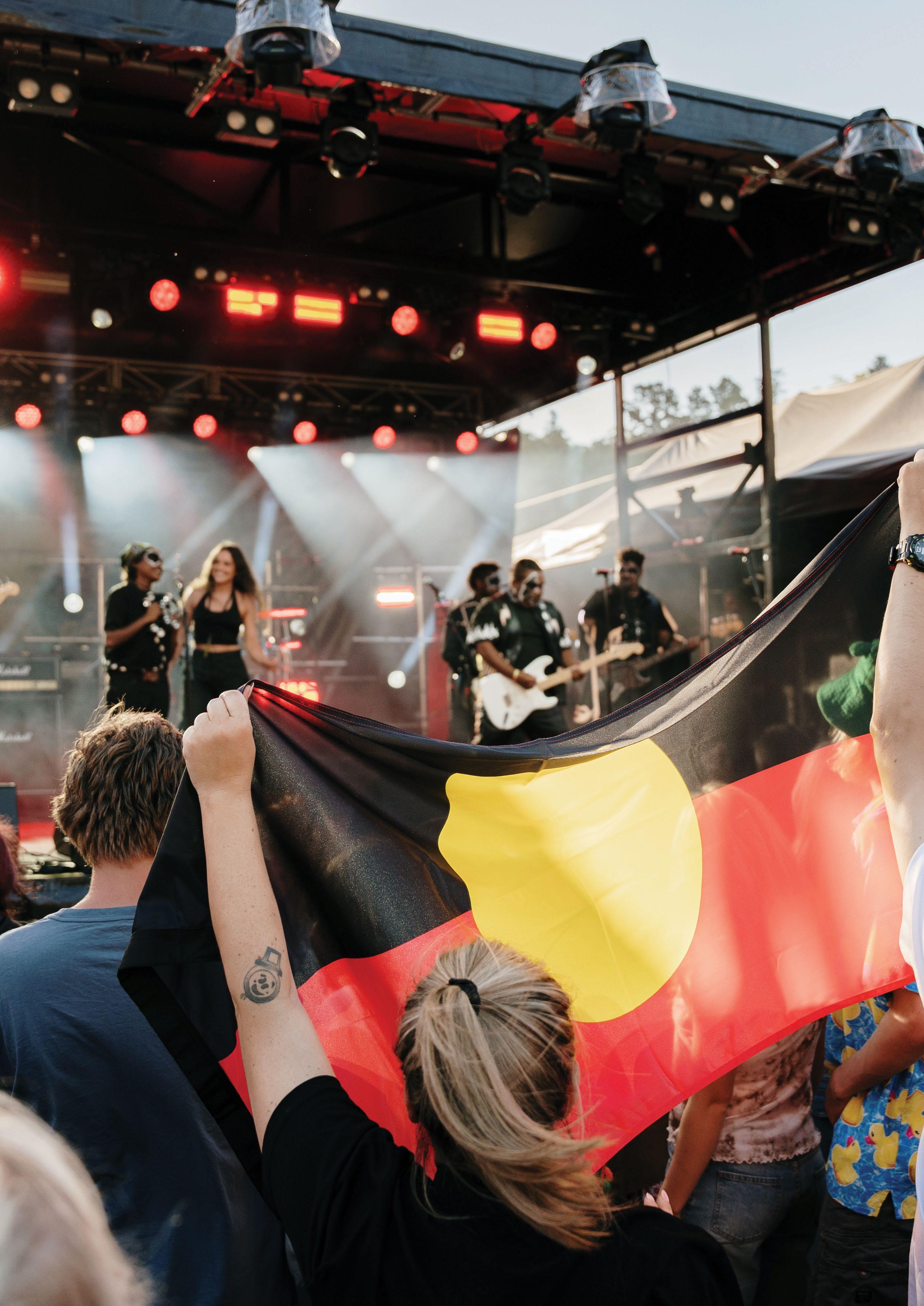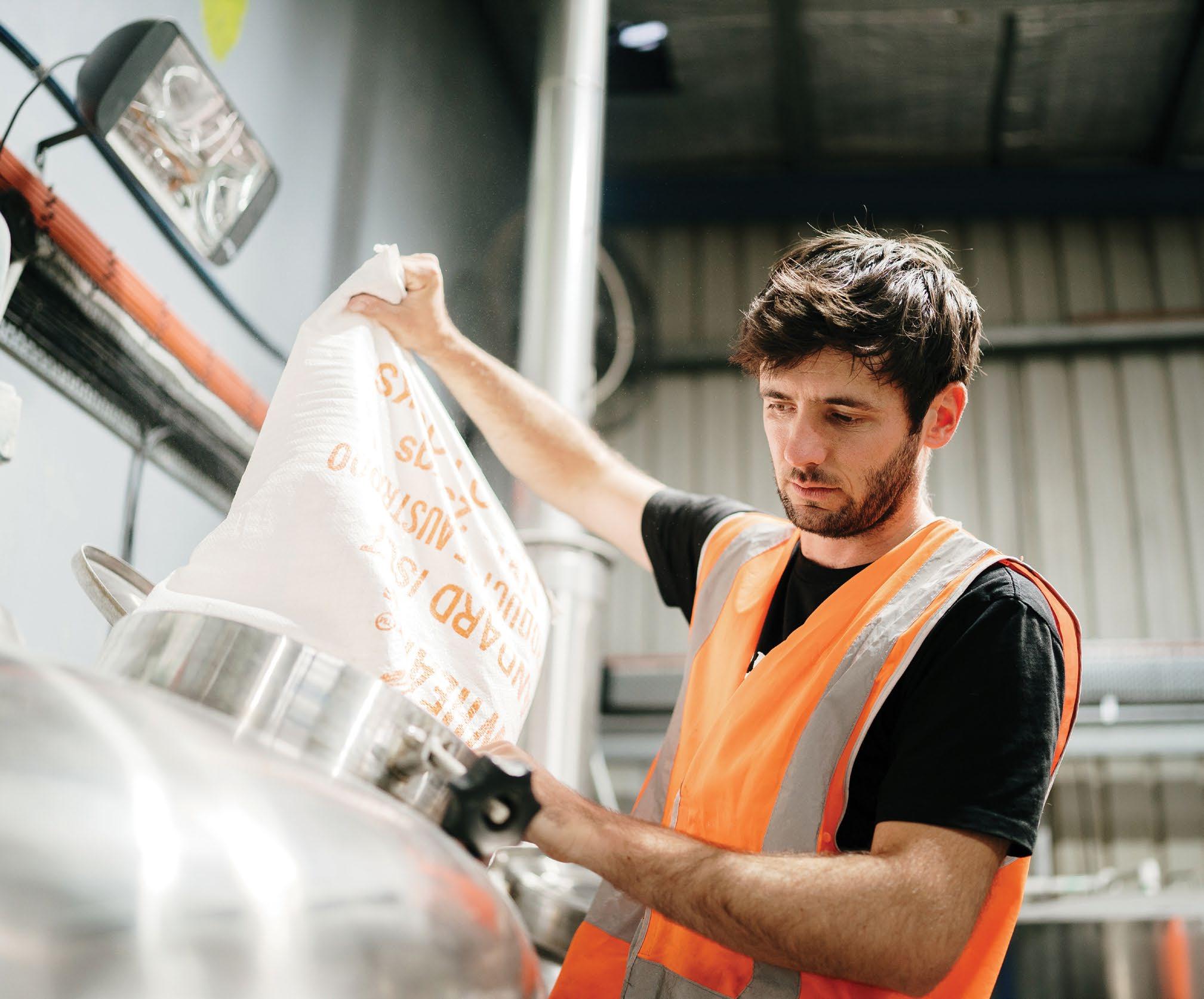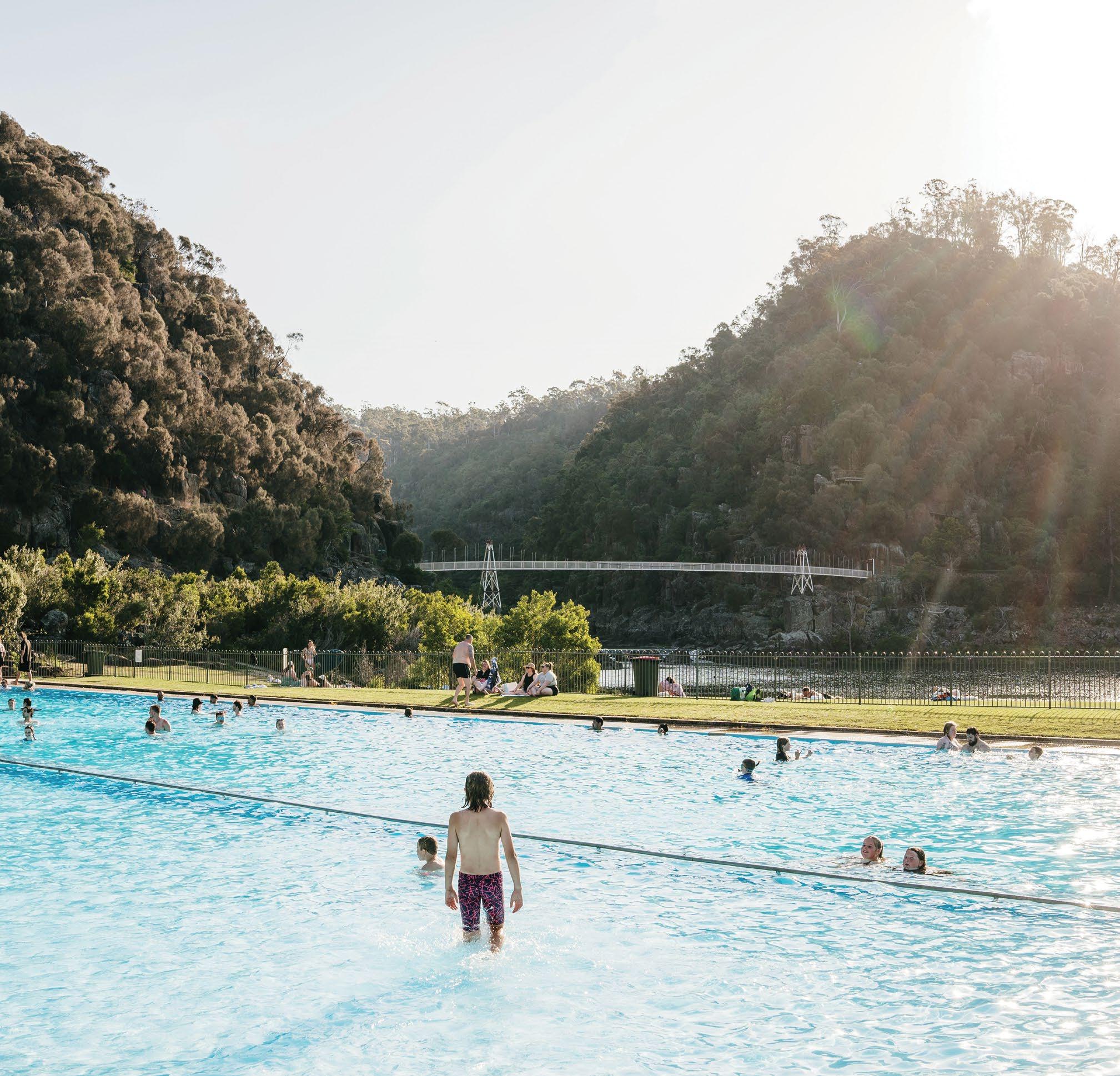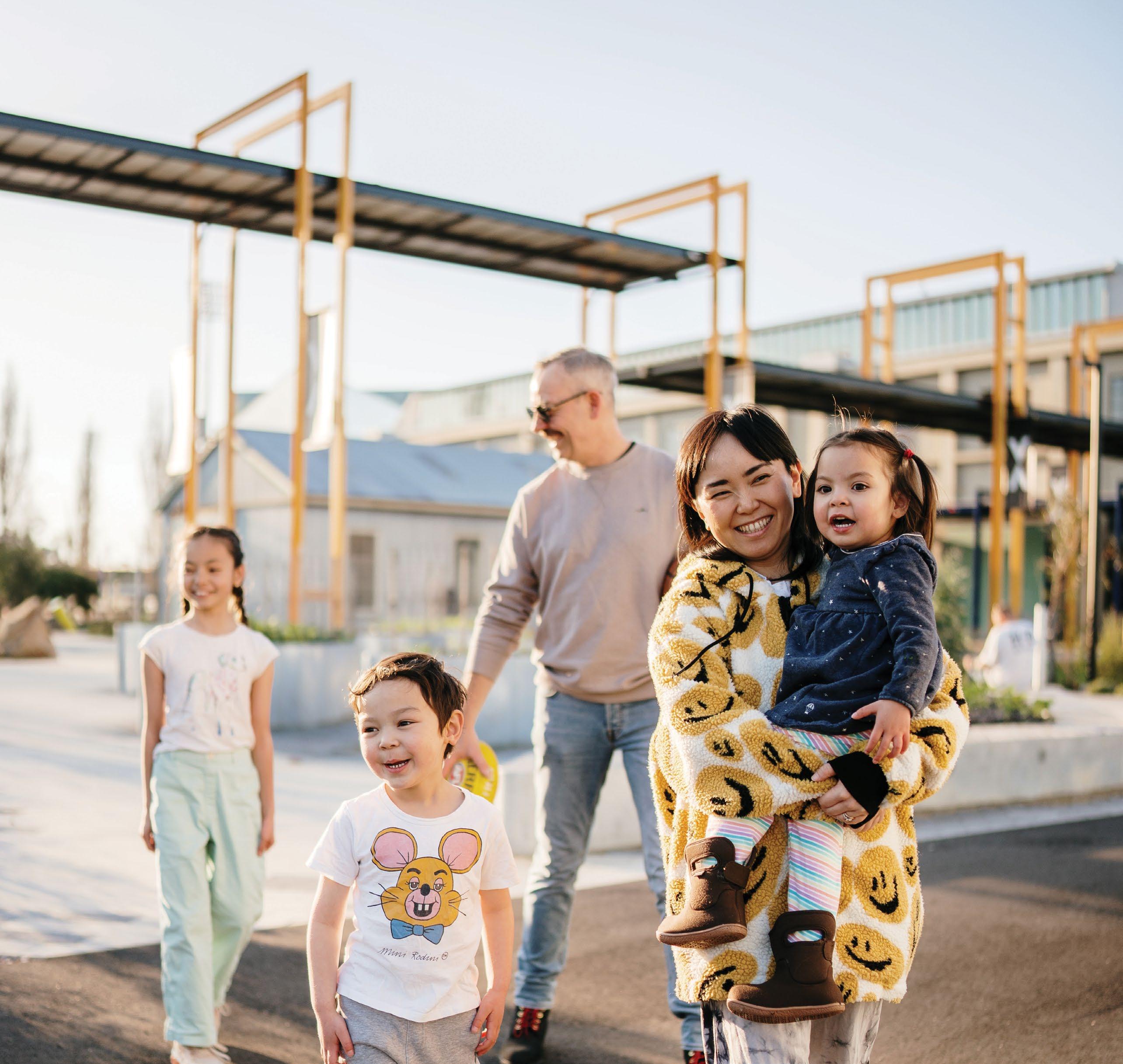

ACKNOWLEDGEMENT OF COUNTRY
We acknowledge Tasmanian Aboriginal People as traditional custodians of this land. We pay respect to Elders past and present, as they hold the memories, traditions, culture and hope for generations to come. We recognise and value Aboriginal histories, knowledge and lived experiences and commit to being culturally inclusive and respectful in our working relationships with Aboriginal People.
INTRODUCTION
Launceston’s future prosperity hinges on enhancing traditional industries—tourism, healthcare, agriculture, knowledge sector, and manufacturing— while embracing economic diversification, infrastructure investment, sustainability, and workforce attraction, retention and development.
Opportunities to grow our tourism offerings include capitalising on our UNESCO Creative City of Gastronomy status, supporting investment in major event and conference infrastructure, and curating year-round events to invigorate both daytime and evening economies.
Launceston can expand these and other sectors by supporting innovation and attracting investments in areas such as advanced manufacturing with a focus on the digital, healthcare, maritime and agricultural industries.
Attracting and retaining skilled professionals, especially 25–34 year-olds, is crucial. Beyond high-value jobs and business growth, younger professionals seek vibrant social spaces, co-working hubs, and cultural venues. They value diverse housing, eco-design, safe walkable areas, public transport, and high-speed digital infrastructure, along with access to nature and rich cultural experiences.


City of Launceston Strategic Plan 2025-2035
SETTING THE SCENE ABOUT US
WHAT WE HEARD
The Strategic Plan is based on results of extensive engagement carried out over recent years, including community submissions on a range of themes through City of Launceston’s award-winning Tomorrow Together program, as well as feedback on specific plans and strategies, which taken together include viewpoints from a broad cross-section of the community. In addition, the Councillors, Council staff and key stakeholders (including a range of non-profit, community organisations and state government bodies) also participated in a series of facilitated workshops to distil the community’s vision for Launceston and formulate goals, objectives and actions based on the City’s strengths and opportunities.
The visioning statements below represent the common strategic themes expressed by community members asked to imagine what Launceston will look and feel like in 10 years.*
*Source: Tomorrow Together Engagement Report (‘A Well-Designed City’, pp. 19-33) based on responses gathered through the Tomorrow Together program and analysed and produced by Capire Consulting. For further details of community engagement which was used to inform this strategy see Appendix A.
Transportation
Launceston has increased public transport services, more active transport in the city centre, reduced reliance on private vehicles, and increased use of electric vehicles.
Environmental sustainability
Launceston continues to protect the natural environment and uses more renewable energy.
Social development
Launceston is more equitable and has inclusive living spaces for all, including people of all ages and from diverse economic and cultural backgrounds. High-quality infrastructure and affordable housing are accessible to the community.
Economic development
Launceston is a vibrant place that attracts young people, visitors and businesses. Local businesses and produce are celebrated and form the unique identity of Launceston.
Character
Elements reflecting Launceston’s unique local character and heritage are respected and celebrated.
Layout of the city
The city’s compact layout provides easy access to services while supporting a diverse mix of homes, including higher density development in selected areas. character and heritage are respected and celebrated.
OPPORTUNITIES
Launceston possesses numerous strengths that position it as a highly liveable, economically significant, and culturally vibrant city in Tasmania. A defining attribute is its stunning natural beauty, with the city nestled around the Kanamaluka/ Tamar estuary and surrounded by scenic landscapes, including the Cataract Gorge. Launceston offers an extensive network of parks, reserves, and conservation areas, making outdoor recreation accessible. It sits at the heart of Northern Tasmania’s tourism, gastronomic, and recreation sectors, and connects to attractions such as Cradle Mountain, the Tamar Valley wine trail, and internationally recognised mountain biking trails. Its rich Aboriginal and European history adds depth to its identity, with a legacy as Australia’s third-oldest city visible in its well-preserved heritage architecture and charming urban character.
Beyond its natural and historical appeal, Launceston is an emerging leader in key economic and technological sectors. The city and region have achieved UNESCO recognition as a Creative City of Gastronomy, highlighting its vibrant food and beverage culture, with over 150 food producers and a renowned wine region. It is also home to leading tertiary institutions including the University of Tasmania and the Australian Maritime College, fostering innovation in fields like maritime engineering and agricultural research. As Australia’s first Gigabit City it provides ultra-fast internet infrastructure that supports digital industries and research. A compact, walkable city centre and strong transport links to mainland Australia further enhance Launceston’s appeal as a progressive regional hub. With a growing focus on sustainability, climate resilience, community vibrancy, and economic diversification, Launceston is well-positioned to strengthen its role as a thriving and forward-thinking city.
CHALLENGES
Despite its many strengths, Launceston faces challenges that may impact its long-term sustainability and growth. One of the most pressing is slow population growth, projected at just 4% over three decades. This stagnation, combined with the loss of young families and professionals, threatens economic vitality and workforce sustainability. Unemployment rates are higher than regional Tasmania and the state, with limited high-value job opportunities. Stronger education, training, and employment pathways are needed to retain talent and attract new residents.
Housing supply, affordability, and diversity are concerns, with demand outpacing supply, driving up rental and property prices. The city’s heavy reliance on cars, with 89% of trips by private vehicles, risks worsening congestion, as key arterial roads near capacity by 2050. Limited public and active transport options make it difficult to reduce car dependency.
Climate change, environmental sustainability and disaster preparedness are key priorities. Launceston faces flood risks, the urban heat island effect, and broader climate impacts including rising costs and infrastructure damage. While sustainability initiatives exist, more action is needed in climate resilience, emissions reduction, and waste management.
The city’s night-time economy is underdeveloped, ranking 80th in Australia despite being Tasmania’s second-largest city. Limited after-hours activity affects tourism and urban vibrancy. Socioeconomic inequality is another challenge, particularly in the northern suburbs, where many face homelessness, economic hardship, and limited access to services. The city has higher-than-average rates of long-term and mental health conditions. While inclusivity and cultural diversity are valued, more must be done to attract a broader demographic and strengthen engagement with Aboriginal communities.
Addressing these challenges requires a clear vision, strategic planning, and coordinated investment in three key areas: Prosperity, Place and People.
HOW TO READ THE PLAN VISION
PILLARS
The three main categories of the strategy. They describe the key themes and make the strategy easier to navigate.
OBJECTIVES
Each goal has three linked objectives. Together they describe the approach we will take to achieve the goal. GOALS
There are three goals under each pillar. They represent the long-term, big picture aspirations of the city.
ACTIONS
To be refined in our Four Year Delivery Plan. While not a complete list, they provide an idea how we will turn objectives into action.
Launceston: A city of history, innovation and opportunity.
Launceston is deeply connected to our history and natural beauty, and will thrive as Northern Tasmania’s economic, cultural, and culinary heart. With a commitment to diverse housing, sustainability, economic growth and innovation, we’re building a city where people feel connected, businesses succeed, and the environment flourishes. Launceston is a place to live, work, play, visit and belong.

1.0 PROSPERITY
Launceston’s future prosperity depends on strengthening its traditional industries—tourism, healthcare, agriculture, the knowledge sector, and manufacturing—while advancing economic diversification, infrastructure investment, sustainability, and workforce attraction, retention and development. The broader region already hosts specialist industrial hubs at Bell Bay, Launceston Airport, Westbury, and Legana. Within the city, there’s significant potential to grow agricultural/gastronomic, technology, education, and cultural hubs, building on assets like UTAS, QVMAG, and AMC.
Tourism growth can be fuelled by leveraging our UNESCO Creative City of Gastronomy status, investment in major event and conference infrastructure, and curating year-round events to
energise both daytime and nighttime economies. Launceston can also strengthen sectors like advanced manufacturing by supporting innovation and attracting investment across the digital, healthcare, maritime and agricultural industries.
Attracting and retaining skilled professionals, especially 25–34 year-olds, is crucial. Beyond high-value jobs and business growth, younger professionals seek vibrant social spaces, co-working hubs, and cultural venues. They value diverse housing, environmentally sustainable design, safe walkable areas, public transport, and high-speed digital infrastructure, along with access to nature and rich cultural experiences.
OUR VISITATION OBJECTIVES ARE: OUR VISITATION ACTIONS WILL INCLUDE:
Objective 1.1(a)
Grow and celebrate our identity as a UNESCO Creative City of Gastronomy.
Objective 1.1(b)
Enhance Launceston’s reputation nationally and internationally as a leading host city for events and festivals, while leveraging our history and natural beauty to encourage extended and expanded stays.
Objective 1.1(c)
Expand Launceston’s position as an arts and cultural hub by providing an environment for creative industries to thrive.
• Partner with tourism bodies and private sectors to enhance and promote visitor experiences and expand UNESCO City of Gastronomy offerings.
• Develop a City of Gastronomy ‘ecosystem’ through innovation hubs, micro-business incubators, and public digital resources (‘every resident an ambassador’).
• Advocate for and support world-class facilities and key infrastructure projects, including a 6,000 seat indoor stadium and a 500+ seat (approx.) conference centre.
• Collaborate with partners on the creation of a Kanamaluka/ Tamar Estuary cultural and recreational precinct.
• Create the first Collection Discovery Centre in Australia, providing public access to the QVMAG collection.
• Undertake an Arts and Cultural Audit to understand the ecology, diversity and sustainability of the sector to guide the planning of future capacity building initiatives.
Goal 1.2 Launceston’s economy is resilient and sustainable, with significant growth in its gross regional product (GRP) through a diverse economic base supported by a skilled workforce, enabling business environment, and facilitation of investment opportunities.
OUR ECONOMIC DEVELOPMENT OBJECTIVES ARE:
Objective 1.2(a)
Capitalise on our competitive advantages by focusing on key sectors including food and agricultural innovation, research & development, advanced manufacturing, healthcare and circular economy initiatives.
Objective 1.2(b)
Position Launceston as a business-friendly city that attracts & nurtures entrepreneurs, startups, and microbusinesses.
Objective 1.2(c)
Advocate and collaborate with the State Government, education institutions, industry partners and non-profits to support improvements in adult literacy (including digital literacy) and to support skills development in key sectors.
Goal 1.3.
OUR ECONOMIC DEVELOPMENT ACTIONS WILL INCLUDE:
• Develop innovation districts and tech hubs focused on maritime, digital technology, medical/health, and green energy sectors.
• Advocate for a regional intermodal hub to improve supply chain efficiencies.
• Continue and promote the ‘Business-Friendly Council’ initiative.
• Collaborate with the State Government on a Northern Tasmania Investment Prospectus.
• Partner with government and educational institutions to provide targeted literacy & skills programs, particularly in underserved areas.
• Strengthen collaboration with universities and training institutions to align education with industry needs.
attractive employment opportunities, enviable lifestyle and our reputation as a forward-thinking city make it the destination of choice for professionals, entrepreneurs and innovators.
Objective 1.3(a)
Position Launceston as a national testbed for urban innovation (e.g., pilot smart city projects, future mobility solutions, and climate-adaptive urbanism).
Objective 1.3(b)
Attract and retain young professionals (25 - 34 year-olds) to Launceston.
• Support businesses in accessing grants and funding for innovation, sustainability, and high-value job creation.
• Develop and showcase urban innovation initiatives in Council’s projects and practices.
• Establish a pilot program to attract and support new residents.
• Enhance and promote Launceston’s lifestyle advantages, with a focus on the needs and interests of 25 - 34 year-olds.
• Collaborate with the Australian Maritime College and the University of Tasmania and industry to attract and retain students and workers.
Objective 1.3(c)
Establish Launceston as a national leader in sustainability through our achievements in circular economy innovation and reducing greenhouse gas emissions.
• Partner with UTas, businesses and the community to reduce Launceston’s greenhouse gas emissions in line with national standards.
• Engage with Circular North to promote and implement bold and innovative initiatives to reduce waste and boost recycling, including incentives for commercial enterprises.
Goal 1.1. Launceston is a premier visitor destination, celebrated for its natural beauty, creative and historic city centre, welcoming community, and rich food culture.
Launceston’s
OUR POPULATION OBJECTIVES ARE: OUR POPULATION ACTIONS WILL INCLUDE:
2.0 PLACE
As Launceston grows toward a population of 100,000, we must take a strategic approach to housing and infrastructure that addresses immediate needs with an eye on longer term growth projections. The next decade presents an opportunity to create a more liveable, connected, and inclusive city while protecting our unique character and sense of place.
A carefully thought-out housing plan will support a diverse mix of homes, ensuring 4,300 new dwellings are delivered by 2035 in priority development areas and through infill development. Medium-density housing will be encouraged near activity centres and transport corridors, with a focus on climate resilience and energy efficiency. We will also support the adaptive reuse of heritage buildings and planning policies that reinforce Launceston’s built heritage and identity.
Housing affordability and security remain key challenges. By partnering with the state government, developers, and Community Housing Providers, we will advocate for social and affordable housing in well-connected locations, ensuring all residents have access to jobs, services, and transport.
A reliable, accessible and diverse transport system is essential to supporting growth and reducing car dependency. While public transport is managed by the state government, we will work proactively with state and regional partners to improve services, including advocating for high frequency transport and better connections between Launceston and surrounding communities, and delivering active (e.g. walking, cycling) or share economy transport links (rental scooters or bikes) that connect to the network.
Goal 2.1 Plan for current and medium-term housing and infrastructure needs while maintaining a focus on a longer-term growth projection of 100,000 residents.
OUR HOUSING OBJECTIVES ARE: OUR HOUSING ACTIONS WILL INCLUDE:
Objective 2.1(a)
Facilitate an increase in housing supply to meet current demand and align with planned growth, aiming and planning for 4,300 new homes in priority development and infill areas by 2035.
Objective 2.1(b)
Enable and encourage delivery of medium density houses in and around activity centres and transport corridors, and more diverse, sustainable and energy efficient housing.
Objective 2.1(c)
Proactively address affordability, homelessness and housing insecurity.
• Implement Neighbourhood Plans and Infrastructure Funding Frameworks for priority growth areas such as South Prospect, Newnham and St Leonards.
• Implement Neighbourhood Plans in Kings Meadows, Mowbray, Lilydale and the northern suburbs.
• Develop a comprehensive plan to encourage infill residential development within a 1.5km radius of the CBD.
• Facilitate improvements to climate resilience and energy efficiency of existing housing stock.
• Encourage developers to create energy efficient housing products that encourage downsizing.
• Partner with the State government and Community Housing Providers to provide an adequate supply of well-located, diverse, affordable, social, and emergency housing.
Goal 2.2 Launceston’s transport system connects communities, reduces car dependency in activity centres and corridors, and promotes active transportation options.
OUR TRANSPORT OBJECTIVES ARE: OUR TRANSPORT ACTIONS WILL INCLUDE:
Objective 2.2(a)
Partner with the state government and local councils to expand access to reliable and frequent public transport services in and around Launceston.
Objective 2.2(b)
Work with partners to enable convenient daily travel by supporting public transport and investing in key road infrastructure between Launceston and rural and regional communities and surrounding facilities (e.g. Launceston Airport, Bell Bay).
Objective 2.2(c)
Develop a safe, pleasant and connected walking and active transportation network that is integrated with the transport system, across Launceston’s urban footprint.
• Advocate for a high-frequency public transport system connecting key areas, supported by a local network.
• Launch a publicity campaign with the state government to improve public transport awareness and ridership.
• Work with the state government and northern councils to strengthen public transport connections between Launceston and rural and regional communities.
• Invest in a seamless active transportation network, including associated infrastructure such as bike parking and shade trees, that links open spaces and waterways, other transport systems, key attractions and activity centres.
Goal 2.3. Launceston’s community is connected to our Aboriginal and built heritage, while growing a city of the future.
OUR HERITAGE OBJECTIVES ARE: OUR HERITAGE ACTIONS WILL INCLUDE:
Objective 2.3(a)
Encourage and facilitate recognition of Aboriginal cultural heritage as a means of retaining a sense of place and connection to Country.
Objective 2.3(b)
Ensure that significant heritage elements are respected while addressing the future housing, commerce and recreational needs of the community.
Objective 2.3(c)
Implement planning guidelines (particularly within the CBD) to encourage adaptive reuse of heritage buildings, and infill development that promotes our city’s builtheritage character.
• Undertake authentic, genuine consultation and build enduring relationships with Aboriginal people in a place-based and finegrained way, and support and collaborate with Aboriginal people to deliver community-led projects.
• Establish the Centre for Aboriginal Science and Education in the redevelopment of QVMAG Royal Park.
• Identify and promote the key elements that express our city’s unique sense of place including histories, stories and architecture.
• Promote adaptive re-use of heritage buildings, especially for community-based uses.
• Complete the Precincts Heritage Register and incorporate Heritage best practice into Special Area Plans.
3.0 PEOPLE
Launceston is a city that thrives on connection - both with nature and with one another. As our community grows and diversifies, every resident should have access to open spaces and facilities that encourage active lifestyles, provide natural retreats, and serve as vibrant meeting points.
Our strategy centres on developing accessible community hubs that support community resilience and diversity, particularly in areas where wellbeing measures are low. These hubs will be key venues for socializing and informal gatherings, nurturing the bonds that keep communities strong. We are committed to future-proofing and enhancing public open spaces, ensuring they are climate-change resilient and inviting for recreation and relaxation.
Recognizing the value of our waterways, we will rehabilitate and integrate riparian corridors into the public space network, reinforcing our connection to nature.
To improve health and wellbeing in the community, we will broaden cultural and recreational participation, addressing barriers to access and championing diverse, locally resonant programs.
Launceston’s City Heart is the cultural and commercial heart of northern Tasmania. To remain relevant our CBD must evolve into a destination that offers unique retail, cultural, and community-based experiences. We will capitalise on our cultural and architectural assets to make a vibrant centre which attracts people to live, work, play, visit and belong.
Goal 3.1 Community members have access to green, diverse, and inclusive open spaces and facilities enabling them to lead active lives, enjoy nature, and connect with others.
OUR OPEN SPACE AND COMMUNITY HUBS OBJECTIVES ARE:
Objective 3.1(a)
Enhance community members’ access to climate-change resilient leafy, well-maintained, inclusive public open spaces, prioritising areas with low wellbeing measures.
Objective 3.1(b)
Leverage Launceston’s network of waterways by rehabilitating and connecting riparian corridors, connecting them with the public open space network and supporting improvements to the Kanamaluka/Tamar Estuary and surrounding precinct.
Objective 3.1(c)
Ensure neighbourhoods are well-served through community activity hubs that are accessible and inclusive, provide a range of amenities, create opportunities for a diverse range of community activities and support Launceston’s diverse cultural, economic, and age groups.
OUR OPEN SPACE AND COMMUNITY HUBS ACTIONS WILL INCLUDE:
• Address the urban heat island effect by investing in greening of our urban areas and engaging the community in tree planting programs, aiming for 30% tree canopy coverage across Launceston by 2035.
• Develop and implement a plan for all households in Launceston to be within a 400-metre walking distance of a park, recreational open space playground, green space, or similar.
• Incorporate rehabilitation and end user interaction with waterways into open space and active transport initiatives at all stages of development.
• Develop a community facilities plan that identifies and prioritises the long term needs for delivery of community services & programs.
Goal 3.2 Participation in cultural and recreational activities is widespread across the community and promotes health and wellbeing at all ages while bridging social, cultural and geographical gaps.
OUR PARTICIPATION OBJECTIVES ARE: OUR PARTICIPATION ACTIONS WILL INCLUDE:
Objective 3.2(a)
Achieve an improvement in health and wellbeing through addressing barriers to inclusion and promotion of physical and social activity such as community arts, sports and recreation.
Objective 3.2(b)
Broaden and increase participation in arts, cultural, and community events to foster community identity, leadership and capacity building, resilience, pride & a sense of belonging.
Objective 3.2(c)
Leverage the City of Gastronomy designation to foster a sense of shared identity, enhance understanding of cultural diversity, promote grassroots food culture, and enhance food security.
• Redevelop the NTCA Sports Complex to support the needs of Northern Tasmania.
• Work towards becoming Australia’s first UNESCO designated Child Friendly City.
• Promote community literacy of healthy lifestyle choices through the Launnie Connecting Community program.
• Develop initiatives specifically aimed at engaging children and youth, people with disabilities, and culturally diverse groups.
• Collaborate with partners to establish a calendar of community cultural events.
• Engage community in shaping positive change through collective action initiatives such as Launnie Connecting Community.
• Collaborate with non-profits to launch a regional zero-foodwaste program linking surplus food to creative initiatives, microbusinesses and relief projects.
• Invest in street food culture.
• Through the Launnie Connecting Community program promote community literacy of healthy food choices and food preparation techniques.
• Promote and support initiatives that increase availability of local seasonal produce.
Goal 3.3 As northern Tasmania’s cultural and commercial centre, Launceston’s historic city heart is buzzing with activity throughout the day and into the night.
Objective 3.3(a)
Intensify baseline activity in the city centre by facilitating an increase in inner-city living and working.
Objective 3.3(b)
Implement bold initiatives that increase nighttime activity, optimise dwell time, maximise appeal to locals and visitors, and add to the City’s vibrancy and safety.
Objective 3.3(c)
Create a walkable centre and optimise the use of public space by reducing car dominance and expanding opportunities for greening and alternative forms of transport.
• Investigate all Council-owned sites, such as public carparks, for opportunities to enhance inner-city living & mixed-use development.
• Establish partnerships or mechanisms to facilitate development of Council-owned land for uses including residential & office space
• Support or coach smaller venues on how to provide nighttime activities.
• In and around the Princess Theatre, improve accessibility, establish the ‘Princess to Princes’ nighttime route and collaborate with partners, businesses and experts to expand the hospitality offering.
• Introduce art-based play programming into the Brisbane Street Mall
• Introduce two-way traffic, street trees and wider footpaths in suitable locations.
• Facilitate alternative forms of transport, especially active and public transport.
City of Launceston Strategic Plan 2025-2035
NEXT STEPS
Following final amendments and Councillor endorsement of the Strategic Plan the document will be submitted to the Department of Premier and Cabinet and made available to the public on Council’s website. A printed copy will also be available at Customer Service.
Council staff will use the Strategic Plan to prepare the Four-year Delivery Plan. This is Council’s key document for medium-term planning. Actions from the Four-year Delivery Plan will then be further developed and delivered in Annual Plans. The Strategic Plan will also be used to assist with prioritisation in other

APPENDIX
COMMUNITY ENGAGEMENT
The key engagement data used to inform the Strategic Plan have been selected based on relevance, high response rates and broad representation of the community.
The 2023 Tomorrow Together - A Well-designed City theme included three questions to directly inform the review and development of the Strategic Plan (what people value about Launceston, aspirations for Launceston in 10 years and key focus areas for Council).
City of Launceston Strategic Plan 2025-2035
